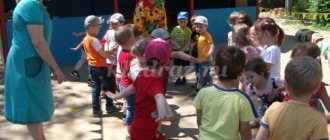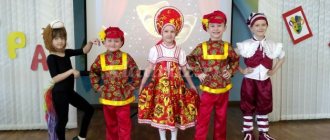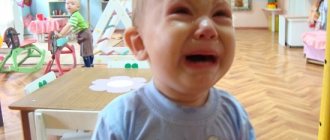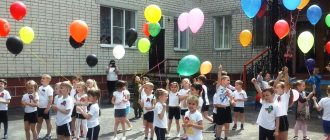Home / Video / Children / A day in the life in kindergarten
Having taken their child to kindergarten in the morning, not every mother and father knows how their child’s life goes in kindergarten. Ordering a video filming “A Day in the Life in Kindergarten” will give you some idea of this. How children study, play and walk will be interesting to see not only for parents, but also for the grown-up children themselves. All videos are designed using children's songs, animated screensavers and footage.
And here you can see vignettes for school and kindergarten.
A day in the life in kindergarten on Lesnoy, part 1
After breakfast, having recharged their energy during the warm-up game, the children sit down with their notebooks and begin their studies with the subject of Spelling. Boys and girls diligently write out their first letters and words with a pencil. In order for your fingers to rest from the labors of studying, you need to do some fun exercises. Now it's time for the poems. Time for business - time for fun. Run, jump and play, have more fun. And now everyone is going for a walk. Professional video filming of children will help you remember these simple but touching moments. Give yourself a gift - order a video of your child from our children's videographer and enjoy watching a film about your baby.
A day in the life in kindergarten on Lesnoy, part 2
It’s good for us to walk on the street together, it’s good for us to play on the street together. Someone is kicking the ball around in unison, “Hip-hip-hurray!” for basketball. Someone is sitting by the sand making Easter cakes, a romantic is picking a bouquet of dandelions. There are swings and toys in every style and color. And after the walk, the guys rehearse the roles of the puppet show. We studied, played, walked, now go to bed. It’s time for “Quiet Hour” in kindergarten. Thanks to the work of our children's videographer, you can see how it was a year later, and after two, and after many, many years. And here you can watch a video of kindergarten graduation.
One day in the life of a young teacher
I wrote this story for future teachers, for those who decided to connect their fate with working in a kindergarten. This work is not easy, but you won’t get so many happy moments anywhere else.
My first day of kindergarten
Morning
Hooray! Finally, I go to work in kindergarten for the first time.
Yesterday the head introduced me to the children of the group. All the children are small and adorable.
In the morning, the kindergarten greeted me with peace, quiet and a delicious smell from the kitchen. My mood improved, I wanted to start a new working day as soon as possible.
In the group that was on the first floor, a nanny met me with the words: “Where are you going, can’t you see that I’m washing the floor. Take off your shoes in the hallway!” A little taken aback by the rudeness, she took off her shoes and went into the room.
The children had not yet been brought, I began to repeat all the words of greeting that I had prepared for the kids.
Finally the first child arrived. Looking at me, he screamed loudly, grabbed my mother by the dress and did not want to let go for a long time, but my mother was in a hurry to go to work and, roughly pushing the baby away, ran away. The baby screamed even louder. Fortunately, he quickly calmed down when he was offered a new car.
The group gradually filled with children, some calmly entered the group, others had to be calmed down and picked up.
By breakfast, my hands were shaking, my voice had disappeared due to the long persuasion of crying children, but despite this, I continued to work with the confidence that everything was wonderful.
At breakfast, some children refused to eat. The nanny forcefully put porridge into them.
In response to my remark about the inadmissibility of force-feeding, she replied that she had no time to wait for them to want to eat.
After breakfast, the children scattered around the group, and my experience was not enough to bring them together for the lesson. I had to skip this lesson.
The children were small, from 2 to 3 years old, so getting ready for the walk took a lot of time. The nanny did not help dress the children; she went “on business” and did not appear in the group until lunch.
Walk
During the walk, I ran from one child to another: one threw sand, the other ate this sand. Some of the children quarreled, and we had to reconcile them.
I was unable to organize the planned outdoor game that day.
While returning from a walk, we were met by the caretaker, she loudly began to tell me to watch the children, not to allow me to touch the walls with my hands, explained that they were covered with expensive material, and because of dirty hands, dirty stains would appear on the walls.
When we barely washed our hands and visited the toilet, our nanny finally appeared. Quickly tidying up the toilet, she disappeared until lunchtime. I was again left alone with the group.
Tired children began to be capricious, it was time to feed them.
The morning mood slowly changed. I didn’t want to work in kindergarten as much as before.
Dinner
My first day turned out to be very difficult.
During lunch, the sanitary and epidemiological station came into the garden. The children ate with appetite when they entered the group.
I was feeding the baby, they stopped near us and began to examine me on hygiene issues. While I was answering, my baby fell asleep next to the bowl of soup. The inspectors were not impressed; for them, “putting the teacher to sleep” was more important.
Quiet hour
When I put the crying and screaming children to bed (again without the help of a nanny), I told myself that the job of a teacher is very difficult and thankless.
None of the kindergarten staff came to see me to help, advise, or simply calm the crying children.
When I looked at the sleeping babies, at their faces, I decided that everything would be fine, that I could handle it.
My worries didn't end there. During a quiet hour, the manager invited the entire team to report to everyone on the results of the inspection of the sanitary and epidemiological station. Leaving the children alone, I had to go to the meeting.
An hour later, I heard a loud roar from my group’s bedroom. When I came running, I saw the following picture: the boy Vanya walked from bed to bed and diligently bit the cheeks of all the children. From the bite marks it was clear that he had already gone around in the second circle.
For me (and for my parents in the evening) it was a shock!
No one can imagine how much effort had to be made to calm the children, and then their parents.
Everything ends someday. This first day of work in kindergarten has also ended.
All the events described were real, they actually happened to me many years ago.
It was not in vain that I described one day of a young teacher . A novice teacher experiences a lot of difficulties, so I urge methodologists and managers to take an interest in the difficulties and successes of young teachers and help them.
If a young educator or teacher receives support, help and approval, he will forever remain at work in a kindergarten or school.
A day in the life in kindergarten on Sverdlova part 1
Drawing lesson is one of the most favorite subjects in kindergarten and primary school for every boy and girl. Some people prefer to draw with colored pencils, while others prefer a picture drawn with a gel pen. But the most important thing is creativity, a moment of artistic inspiration and flight of fancy. Some parents save their children's drawings in the family archive, like a baby photo or a baby video. They decorate the walls in the children's room with drawings or attach pictures to the refrigerator, arranging a home exhibition of children's creativity. But at home, parents see the finished result, and videotaping a drawing lesson allows them to see the process of creating an artistic masterpiece. And here you can see photos of children in kindergarten.
One day in kindergarten article
“Childhood is an everyday discovery of the world,” wrote V. A. Sukhomlinsky. Our children are distinguished by their curiosity, kindness, and spontaneity. Look how fun and friendly our group lives! It’s very nice when children happily go to kindergarten in the morning and don’t want to leave in the evening! This means that children are happy and comfortable in the group, where friends and understanding adults are waiting for them!
Every day in the Yablonka kindergarten cannot be everyday and monotonous. It is full of new emotions, adventures, pleasant events, interesting and funny stories. As in any kindergarten, there are both routine moments and planned educational activities. We, like wizards, try every day to transform systematic moments into an amazing world of knowledge. I will show you just one page from a huge magical book of preschool childhood.
Children are accepted in a group. I don’t just monotonously receive children, but I try to hug and give the child a smile, and be sure to ask a few general questions. How you greet the day is how you will spend it. Our children are in a hurry to do their morning exercises. After all, we have her sometimes in the group, sometimes in the fresh air, sometimes with attributes in the music room. Most of all, they like exercises with transformation, where the guys try on the roles of animals, birds, and people of different professions to the accompaniment of music. This whole complex is, of course, reinforced by outdoor and didactic games.
Breakfast is a special ritual. Just as not all children love porridge and milk. To interest the child, a competition “Wow, how big I am!” is held. There are scales in the medical office, where the child is clearly shown how healthy it is to eat in the morning.
You can write a separate story about educational activities directly. After all, the professionalism of a teacher is manifested in a creative, extraordinary approach to developing a lesson plan. We try to draw up a plan so that the children’s dialogues can be heard, and not the instructive speech of the teacher. I would like to emphasize that most classes are conducted outdoors, even in winter. After all, knowledge can be consolidated with the help of objects that surround us.
Walks in kindergarten are always eventful. In addition to routine moments, the teacher pays special attention to children’s independent play. I try to be just an observer, an assistant, and a participant. Walks are often accompanied by entertainment and magical journeys.
Well, it’s lunch time...the catering unit’s stand is updated daily. It is worth noting the work of the assistant teacher. She pays great attention to aesthetic table setting.
During sleep time in each bedroom you can hear a fairy tale or story from the teacher, as well as accompanying relaxation music. All conditions for relaxation and recovery have been created for children. The highlight is special tactile rugs made by children together with their parents. Also in the bedroom there is a relaxation corner where the child can retire at any time.
The second half of the day is teachers’ favorite time, when they can engage in individual work with children, creative or project activities. I pay special attention to entertainment evenings, where, together with the music director, I try to create a festive mood for the children.
In the evening, children happily wait for their parents, but at the same time, waiting for the next day, they leave kindergarten with sadness. After all, every employee of the Yablonka kindergarten tries to create comfortable conditions for the comprehensive development of children.
What is chess - a sport, a game, a science, an art?
There is a lot that can be said about chess. This is how great people speak about them.
Sukhomlinsky: “Without chess it is impossible to imagine the full education of mental abilities and memory... chess is an excellent school of consistent logical thinking. Playing chess disciplines thinking, fosters concentration, and develops memory.”
Today, chess is the most common board game, combining elements of sportsmanship, the science of calculating multi-move combinations and art, psychological mastery of the game and silent influence on the enemy. Of course, playing chess has great educational significance, it teaches you to think logically, develops perseverance and concentration, teaches you to show restraint and not give in to panic during the game, plan your actions 3-5 steps ahead, and contributes to the formation of a truly creative personality. While playing chess, players' character emerges and many personality traits are revealed that they were not even aware of.
An important achievement of the work can be considered the increased interest in the game of chess among children and their parents and the desire to learn how to play this developing, disciplinary game. Children learned to reason, draw conclusions, they became more developed in logical thinking, the ability to work in pairs, the ability to maintain team spirit and play for themselves.
There is no limit to improvement in chess; there is always something to learn and something to be surprised by. Their depth and beauty are inexhaustible, and therefore they can become your companion for life.
Anyone can be taught to play chess, but to do this you need to be patient. Our goal is not to raise champions, but to instill interest in wise play. Chess is a whole world of logic and emotions, a beautiful and passionate world with its ups and downs, joys and misfortunes. We have the power to give a child a golden key to this magical world.
Training is carried out on the basis of general methodological principles:
- The principle of developmental activity: playing not for the sake of playing, but for the purpose of developing the personality of each participant and the entire team as a whole.
- The principle of active involvement of each child in the play action, and not passive contemplation from the side;
- The principle of accessibility, consistency and systematic presentation of program material.
- Basic teaching methods:
- The formation of chess thinking in a child goes through a number of stages:
- ∙ At the initial stage, playful, visual and reproductive methods predominate.
Playing chess requires the ability to think, comprehend, compare, compare, and, most importantly, act.









